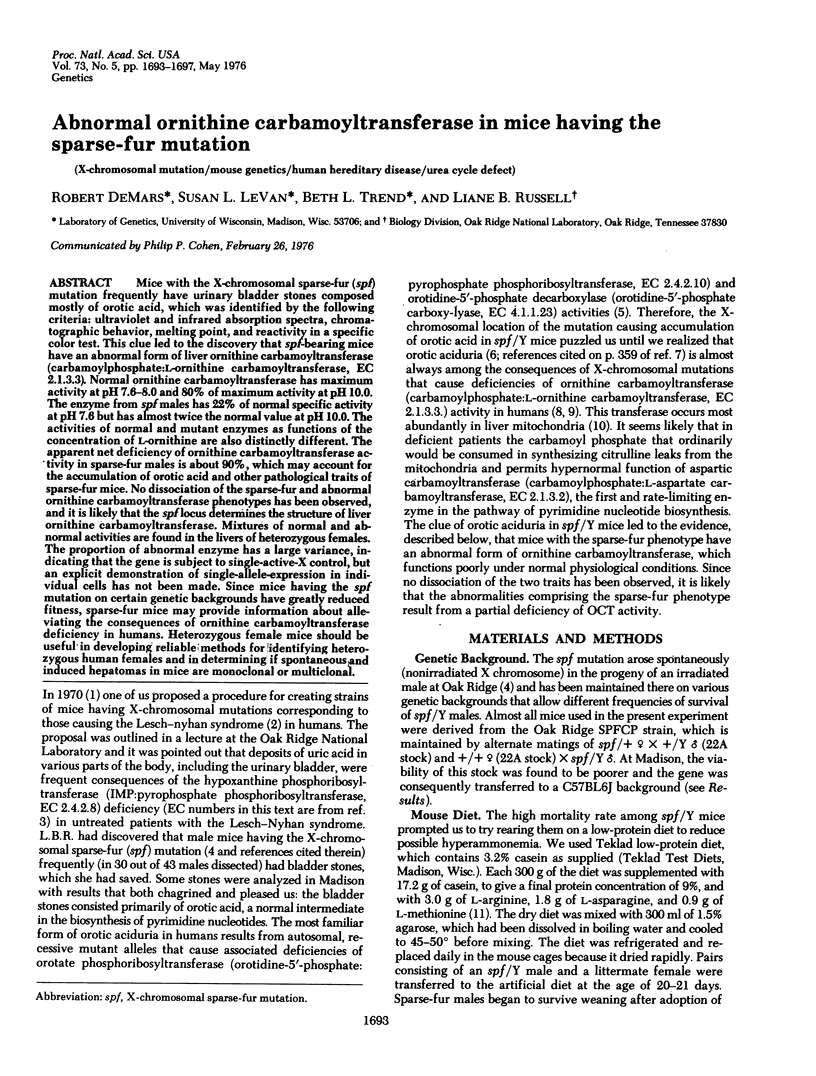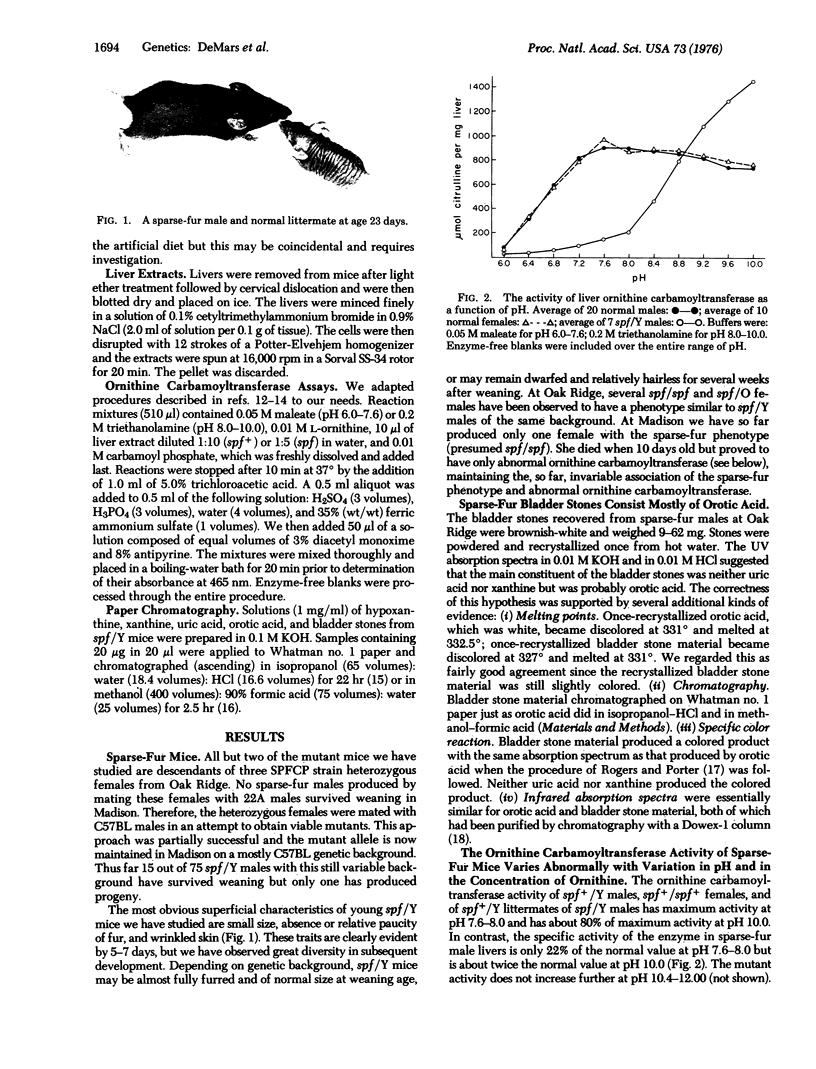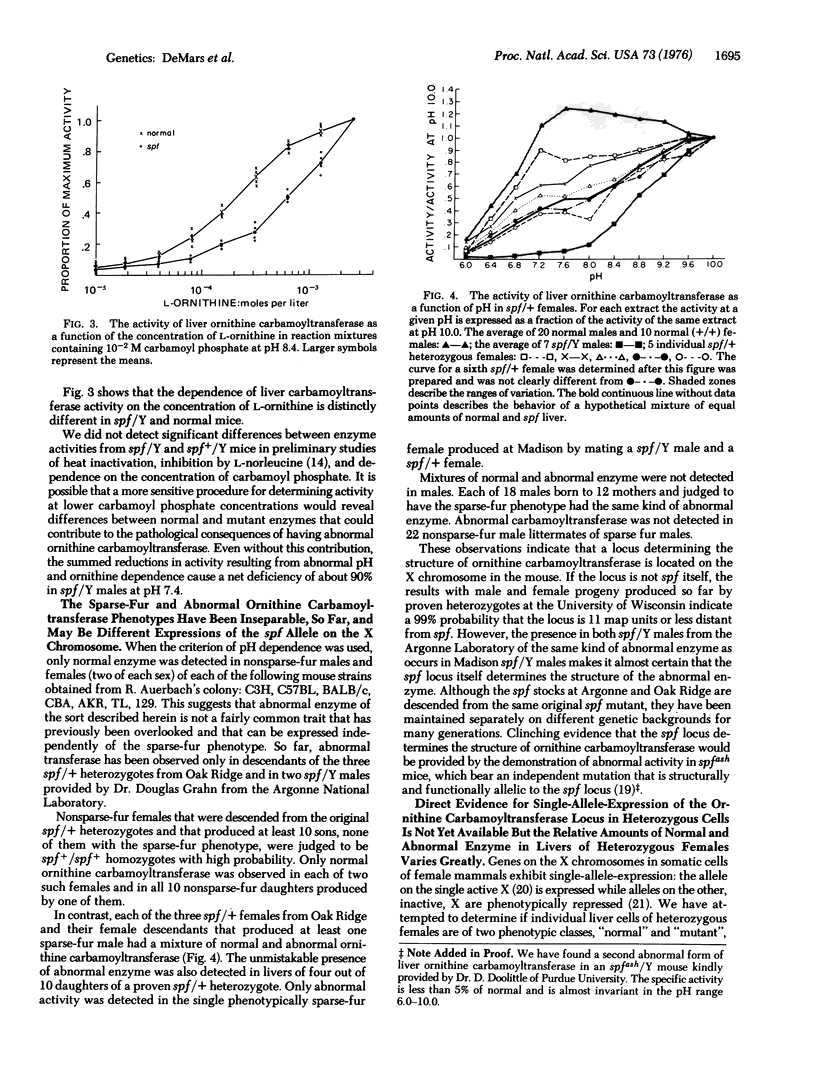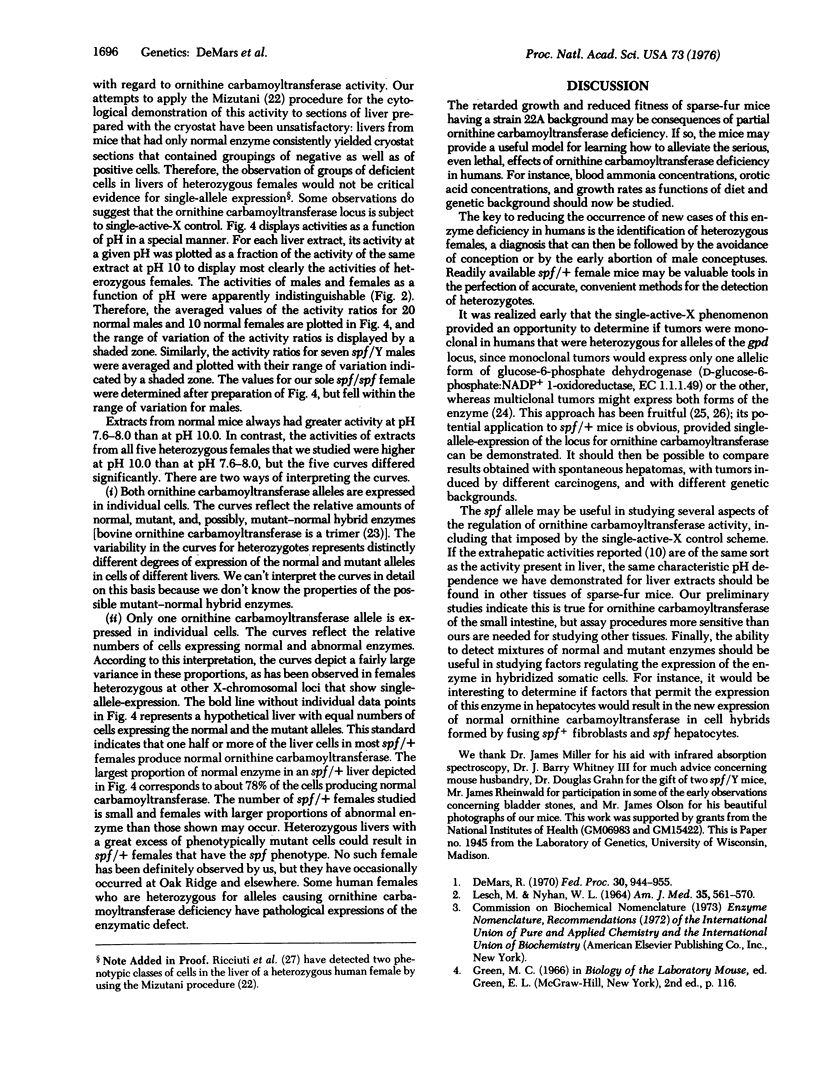Abstract
Mice with the X-chromosomal sparse-fur (spf) mutation frequently have urinary bladder stones composed mostly of orotic acid, which was identified by the following criteria: ultraviolet and infrared absorption, spectra, chromatographic behavior, melting point, and reactivity in a specific color test. This clue led to the discovery that spf-bearing mice have an abnormal form of liver ornithine carbamoyltransferase (carbamoylphosphate:L-ornithine carbamoyltransferase, EC 2.1.3.3). Normal ornithine carbamoyltransferase has maximum activity at pH 7.6-8.0 and 80% of maximum activity at pH 10.0.
Full text
PDF




Images in this article
Selected References
These references are in PubMed. This may not be the complete list of references from this article.
- Campbell A. G., Rosenberg L. E., Snodgrass P. J., Nuzum C. T. Ornithine transcarbamylase deficiency: a cause of lethal neonatal hyperammonemia in males. N Engl J Med. 1973 Jan 4;288(1):1–6. doi: 10.1056/NEJM197301042880101. [DOI] [PubMed] [Google Scholar]
- Cathelineau L., Saudubray J. M., Polonovski C. Heterogenous mutations of the structural gene of human ornithine carbamyltransferase as observed in five personal cases. Enzyme. 1974;18(1):103–113. doi: 10.1159/000459417. [DOI] [PubMed] [Google Scholar]
- Cathelineau L., Saudubray J. M., Polonovski C. Ornithine carbamyl transferase: the effects of pH on the kinetics of a mutant human enzyme. Clin Chim Acta. 1972 Oct;41:305–312. doi: 10.1016/0009-8981(72)90525-6. [DOI] [PubMed] [Google Scholar]
- DEMARS R. SOME STUDIES OF ENZYMES IN CULTIVATED HUMAN CELLS. Natl Cancer Inst Monogr. 1964 Apr;13:181–195. [PubMed] [Google Scholar]
- DeMars R. Genetic studies of HG- PRT deficiency and the Lesch-Nyhan syndrome with cultured human cells. Fed Proc. 1971 May-Jun;30(3):944–955. [PubMed] [Google Scholar]
- Doolittle D. P., Hulbert L. L., Cordy C. A new allele of the sparse fur gene in the mouse. J Hered. 1974 May-Jun;65(3):194–195. doi: 10.1093/oxfordjournals.jhered.a108500. [DOI] [PubMed] [Google Scholar]
- Fialkow P. J. The origin and development of human tumors studied with cell markers. N Engl J Med. 1974 Jul 4;291(1):26–35. doi: 10.1056/NEJM197407042910109. [DOI] [PubMed] [Google Scholar]
- Goldstein A. S., Hoogenraad N. J., Johnson J. D., Fukanaga K., Swierczewski E., Cann H. M., Sunshine P. Metabolic and genetic studies of a family with ornithine transcarbamylase deficiency. Pediatr Res. 1974 Jan;8(1):5–12. doi: 10.1203/00006450-197401000-00002. [DOI] [PubMed] [Google Scholar]
- HURLBERT R. B., SCHMITZ H., BRUMM A. F., POTTER V. R. Nucleotide metabolism. II. Chromatographic separation of acid-soluble nucleotides. J Biol Chem. 1954 Jul;209(1):23–39. [PubMed] [Google Scholar]
- Hsia Y. E. Inherited hyperammonemic syndromes. Gastroenterology. 1974 Aug;67(2):347–374. [PubMed] [Google Scholar]
- LESCH M., NYHAN W. L. A FAMILIAL DISORDER OF URIC ACID METABOLISM AND CENTRAL NERVOUS SYSTEM FUNCTION. Am J Med. 1964 Apr;36:561–570. doi: 10.1016/0002-9343(64)90104-4. [DOI] [PubMed] [Google Scholar]
- Lyon M. F. X-chromosome inactivation and developmental patterns in mammals. Biol Rev Camb Philos Soc. 1972 Jan;47(1):1–35. doi: 10.1111/j.1469-185x.1972.tb00969.x. [DOI] [PubMed] [Google Scholar]
- Marshall M., Cohen P. P. Ornithine transcarbamylase from Streptococcus faecalis and bovine liver. I. Isolation and subunit structure. J Biol Chem. 1972 Mar 25;247(6):1641–1653. [PubMed] [Google Scholar]
- Marshall M., Cohen P. P. Ornithine transcarbamylase from Streptococcus faecalis and bovine liver. II. Multiple binding sites for carbamyl-P and L-norvaline, correlation with steady state kinetics. J Biol Chem. 1972 Mar 25;247(6):1654–1668. [PubMed] [Google Scholar]
- Mizutani A. Cytochemical demonstration of ornithine carbamoyltransferase activity in liver mitochondria of rat and mouse. J Histochem Cytochem. 1968 Mar;16(3):172–180. doi: 10.1177/16.3.172. [DOI] [PubMed] [Google Scholar]
- RUSSELL L. B. Mammalian X-chromosome action: inactivation limited in spread and region of origin. Science. 1963 May 31;140(3570):976–978. doi: 10.1126/science.140.3570.976. [DOI] [PubMed] [Google Scholar]
- Raijman L. Citrulline synthesis in rat tissues and liver content of carbamoyl phosphate and ornithine. Biochem J. 1974 Feb;138(2):225–232. doi: 10.1042/bj1380225. [DOI] [PMC free article] [PubMed] [Google Scholar]
- Rogers L. E., Porter F. S. Hereditary orotic aciduria. II. A urinary screening test. Pediatrics. 1968 Sep;42(3):423–428. [PubMed] [Google Scholar]
- Rogers Q. R., Harper A. E. Amino acid diets and maximal growth in the rat. J Nutr. 1965 Nov;87(3):267–273. doi: 10.1093/jn/87.3.267. [DOI] [PubMed] [Google Scholar]



